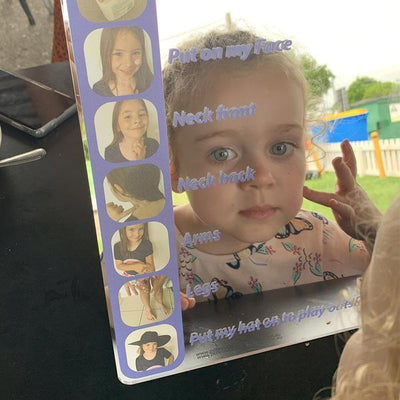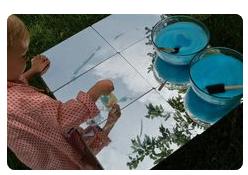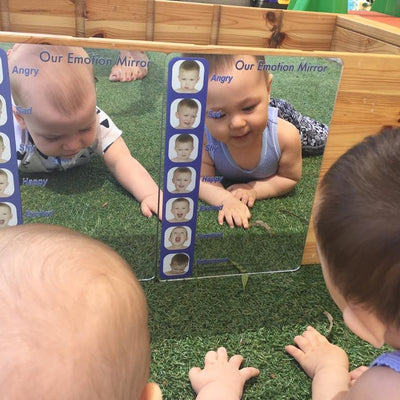Benefits of Mirrors in Early Education Services
Using mirrors with infant and toddlers in a early education setting is a developmental tool used to teach self recognition. Young children can also develop pre-reading skills from the use of mirrors by learning pronunciation, vocabulary, and the skill of identification.
Practice Motor Skills- Have infants or toddlers try to “catch” bubbles as you slowly blow the bubbles against the mirror. This is a great way for infants to learn to follow with their eyes and is a great opportunity to increase hand-eye coordination. Have older toddlers practice getting dressed in the mirror. At first, this should be a simple task, such as putting on a jacket or socks. Praise every attempt the children make.
All of the PDF Education Supplies mirrors are safe to use around children as they will not shatter and have rounded corners for added safety
-
Feb 13, 2021
Mirror Play
A mirror is great for exploring small, interesting loose parts.
Try painting clouds on the sky it is a terrific mix of sensory play and art. The blue sky reflecting in the mirror provides the perfect surface for painting big, fluffy clouds.
A mirror is a wonderful place for children to explore seasonal materials. Try a mix of natural and artificial items for the nature table. The colours and textures are made even more interesting by the mirrored surface beneath them.
A paintbrush glides so smoothly over the mirror is lovely too. This activity always keeps the kids busy and entertained for ages. And when we’re finished, simply wash the mirror in soapy water and soft cloth and it is ready for another fun day in the future
-
Nov 27, 2020
Benefit of mirrors for children with Autism
Who's That in the Mirror? Autism and the Developing Sense of Self EXECUTIVE SUMMARY: A small, exploratory British study of preschoolers with either autism or Down syndrome and typically developing toddlers looked at how each group of children acted toward their reflections in a mirror. They looked for trends, both group trends (i.e., how do autistic children differ from their non-autistic developmental peers, represented in different ways by the Down syndrome group and the younger typically developing group, whose chronological age matched the developmental ages found for both developmentally-disabled groups), and within-group trends relating mirror behavior to performance on a test of mirror self-recognition (i.e., do they know that the person in the mirror is their own reflection). They found that although the autistic children did not differ from the younger, typically developing children in the amount of time spent looking at their own faces, but that they did spend...
-
Jan 14, 2020
Mirrors for Face painters
Face Painters mirror light weight shatterproof acrylic with safety round corners. This is a great addition to you kit as it is completely safe to use around children.
-
Nov 06, 2017
Showing 1 - 4 of 4 results




